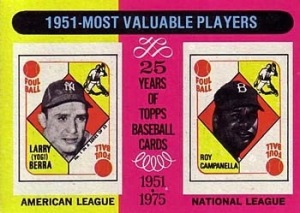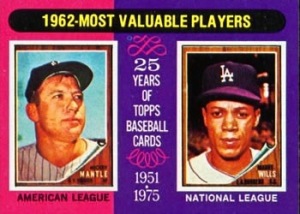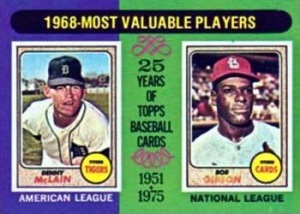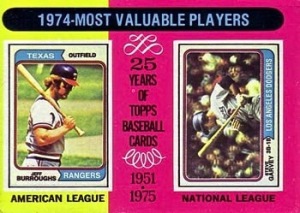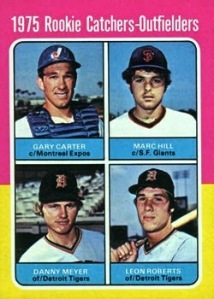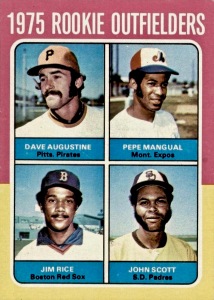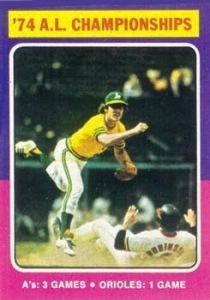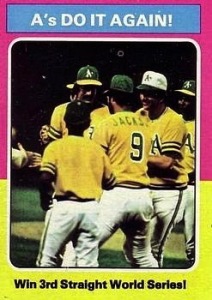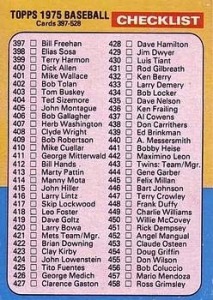
Prologue: Simply Terrible? The primary of a two half ode to the 1975 Topps baseball card set, this put up describes the organizational structure, key options, and a few of what makes the set particular to collectors and fanatics.
As talked about previously, the 1975 Topps baseball card set by no means held a lot attraction for me, even again on the age of 10 after I purchased my first pack for 15 cents or so. I bear in mind considering they appeared cheesy and low cost – means too cartoonish, even for a wide-eyed child. The playing cards appeared thinner too and haphazardly made. An sudden departure from the basic seems to be of yore. I couldn’t have expressed it on the time, however maybe I sensed they lacked some type of “gravitas”.
For somebody who loves brilliant colours and appreciates inventive efforts the primary downside was/is an advanced one: the essential look and structure of the cardboard fronts certainly is colourful and revolutionary, nevertheless it’s additionally objectively atrocious. The font is simplistic and the colour schemes are jarring, far-fetched – virtually as if comedian ebook artists had taken over Topps Co. headquarters, introduced their precognitive fever dream of the neon-soaked Eighties to life, then married that with these ubiquitous (and unlucky) early Seventies colours – avocado inexperienced, burnt orange, and earthy brown. Whoa!
Listed here are a number of worthy examples: Tom Murphy (#28), trying somewhat stiff, green-on-green lefty Ken Holtzman (#145), and Sparky Anderson whipping boy John Vukovich (#602), who (fortunately) ‘hit’ his means out of the Large Pink Machine lineup early in ’75.
The cardboard again structure isn’t nice both. Good that it incorporates commonplace Topps information (private information, minor and main league statistics, a trivia cartoon, and transient abstract of profession highlights to this point) however there are more unusual coloration selections and unusually poor distinction between the black/inexperienced font and pink/crimson background.
It didn’t assist that most of the participant poses appeared forgettable and off; we’d seen most of them earlier than. ‘Correct’ and neatly outlined borders on the cardboard fronts appear to have gone out the window too, with at the least as a lot encroachment on participant photos as in earlier years.
However what if I’ve simply been means too essential all these years?
I ask as a result of by some means, 50 years after they hit the shops, these playing cards have grown on me. Now these colours are vibrant and edgy. The block lettering has 3D energy. The participant signatures are daring and genuine trying. The funky mid-Seventies types of the gamers are iconic. There are some cool and sneaky-good motion pictures combined in. The playing cards really feel thick and substantial, in comparison with later years anyway, and have a pleasant gloss. Even the cartoon baseball within the backside proper nook with the participant’s place is a pleasant contact, as is the ersatz star, indicating gamers who have been All-Stars the earlier season.
They grew on me a lot that ultimately I couldn’t resist a one fell swoop eBay buy of the entire set. [Note: I cannot recommend this practice and wouldn’t do it again – one misses out on the fun and meticulous unveiling of the ensemble…though it probably is the most economical way to go.]
The set, launched suddenly reasonably than incrementally by collection, occurred to commemorate the twenty fifth Anniversary of Topps baseball playing cards and boasts their final cardboard of Bob Gibson (#150), Frank Robinson (as a participant, #580), and Harmon Killebrew (#640), plus rookie playing cards of Robin Yount (#223), George Brett (#228), Jim Rice (#616), and Gary Carter (#620), all Corridor of Famers. We additionally discover rookie playing cards of perennial All-Stars Keith Hernandez (#623) and Fred Lynn (#622).
The unique eye-catching design of the playing cards, a sub-series chronicling each AL and NL MVP on Topps playing cards from 1951-74, a real one in all a sort card, and that particular mid-’70s trend all lend sufficient inventive and historic advantage to encourage this put up. So right here we go…let’s take a detailed have a look at the 660 card set to see what makes it particular! (Apart from the truth that Topps additionally supplied a ‘mini’ 1975 set, with reproduction playing cards measuring 2 1/4” x 3 1/8” reasonably than the standard 2 1/2” x 3 1/2”. As a child I by no means noticed these, and won’t point out them additional right here.)
The large take care of this ensemble is the outlandish coloration palette. There’s a dizzying array of coloration mixtures, some solely subtly completely different than others (is that tan, or only a unhealthy orange print? mild crimson or darkish orange?), generally maddeningly so. Particularly, orange and crimson hues fluctuate, making the crimson/yellow/blue and orange/yellow blue schemes (Bob Gibson vs. Bake McBride under) powerful to differentiate. Fortunately, in that case the distinction within the participant identify font (crimson vs. black, respectively) makes sorting attainable.
Talking of sorting – any sense of order within the set is elusive, so I set out looking for some…and did! Little question somebody already figured this out way back, but when so I haven’t discovered something about it on-line or elsewhere. If anybody has, I’m somewhat jealous…however have some pity for them too.
Turns on the market are 17 distinct coloration patterns, which, when taken in all collectively call to mind piles of wrapper confetti from an exploded gum and sweet bar aisle. Listed here are some favorites of every scheme, organized (roughly) by coloration. (Captions doc so as the colour of the highest (bigger) border portion of the cardboard, coloration of the underside border portion of the cardboard, coloration of the workforce identify font, and variety of playing cards of every configuration).
The colour schemes are assigned to gamers randomly, as a right of workforce colours, and there’s no workforce uniformity both, not like in earlier years. About all we are able to do is word the disparate portions of every and surprise what Topps designers have been considering (and/or smoking) on the time of design. I can’t even identify a favourite of the lot as a result of all of them look ridiculous on their very own. Perhaps the purple/pink/yellow ones (Dave Money) for his or her great brightness and sheer chutzpah? Or maybe that kooky pink/yellow/blue sample (George Foster)? Robust name!
Sub-series of the Set:
The set begins with a collection of seven identically coloured playing cards (as a lot as that’s attainable with this catalogue (word the range under)) that chronicle notable accomplishments from the season earlier than. There’s Hank Aaron breaking the profession residence run document (#1), Bob Gibson recording his 3,000th strikeout (#3) and Al Kaline getting his 3,000th hit (#4), amongst others.
The subsequent sub-series options playing cards (#189 – 212) displaying MVPs of every league via the primary 25 years of Topps. These weren’t a favourite of my child self, however they’re an attention-grabbing strive. With no (Topps) playing cards of Roy Campanella in 1951 and 1953, they needed to retroactively create playing cards for him. Identical with Maury Wills (1962).
Listed here are a few others, highlighting stars of the occasions and completely different seems to be of the many years. All playing cards of this collection are both pink/yellow, purple/pink, or inexperienced/purple.
The backs briefly summarize highlights from every MVP’s stellar season with the format, “For Yogi Berra, 1955 was an incredible yr as a result of…”, and a listing of three defining exploits from the participant’s season. I selected that instance as a result of, curiously, the second bullet for Mr. Berra on the 1955 MVP card (#193) reads “He virtually tied seventh sport of World Collection with drive down leftfield foul line at Yankee Stadium.” (emphasis mine). Ho ho. Absolutely Yogi had extra spectacular moments that season, as memorable as that foul ball may need been. Or perhaps not!
As standard, the statistical leaders (batting common, residence runs, RBI, stolen bases, victories, ERA, strikeouts, and “Main Firemen” (saves + wins)) from the earlier yr are represented (#306-313), with the chief of every league pictured and high 10 leaders listed on the again. From right here on out the pink/yellow/blue coloration scheme carries the day.
Promising rookies are once more given their very own playing cards (#614-624), however even much less house than standard (4 to a card).
The earlier season’s Championship Collection contests are chronicled in simply two playing cards, #459-460, with the Nationwide League losers (#460) fittingly assigned the dour brown/orange/yellow scheme.
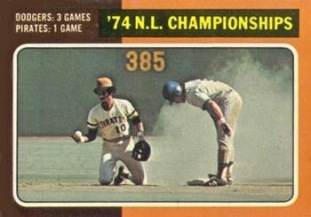
The AL Collection (#459) received the purple/pink/yellow combo whereas the 1974 World Collection is described by playing cards #461-466, all in additional of that jarring fluorescent pink and yellow. Someway they picked a coloration mixture which each enhances and clashes with these brighter than life A’s uniforms (aptly described in Roger Angell’s basic The Summer time Sport as “Kelly Inexperienced, Wedding ceremony Robe White, and California Gold”). Whereas this A’s WS celebration card (#466) is just not the “one in all a sort” card talked about earlier, there’s a fun story behind it, courtesy of SABR card weblog guru Jason Schwartz.
There are 5 checklists, represented by two schemes – the ever-present pink/yellow (#126, 386, 646), and the (for my part) unlucky tan/blue (#257, 517).
Lastly, it’s price noting that for the primary time managers have been denied their very own card. Every of the 2 years prior noticed them sharing playing cards with their coaches (the place managers at the least received top-billing) and earlier than that they’d at all times loved their very own, however in 1975 they have been squeezed into the underside lefthand nook of their workforce’s card. Right here’s an instance – Sparky Anderson and the eventual champs of 1975:
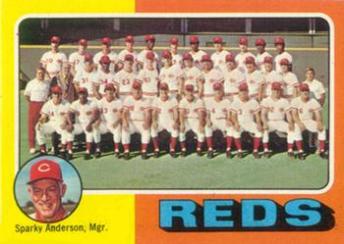
Keep tuned for half two, the place we’ll check out among the excessive (and low!) factors of the set.
Trending Merchandise

